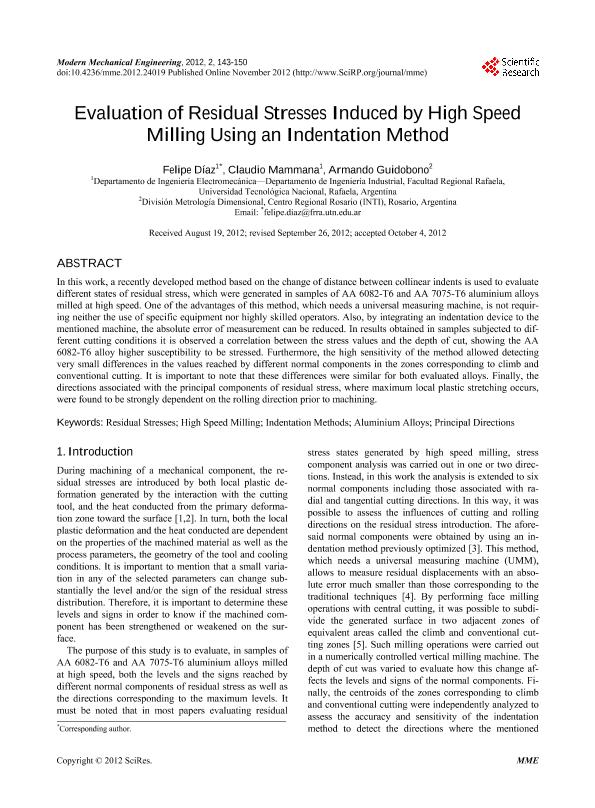Mostrar el registro sencillo del ítem
dc.contributor.author
Diaz, Felipe Victor

dc.contributor.author
Mammana, Claudio Alejandro

dc.contributor.author
Guidobono, Armando
dc.date.available
2023-05-15T11:27:28Z
dc.date.issued
2012-11
dc.identifier.citation
Diaz, Felipe Victor; Mammana, Claudio Alejandro; Guidobono, Armando; Evaluation of Residual Stresses Induced by High Speed Milling Using an Indentation Method; Scientific Research Publishing; Modern Mechanical Engineering; 2; 4; 11-2012; 143-150
dc.identifier.issn
2164-0181
dc.identifier.uri
http://hdl.handle.net/11336/197445
dc.description.abstract
In this work, a recently developed method based on the change of distance between collinear indents is used to evaluate different states of residual stress, which were generated in samples of AA 6082-T6 and AA 7075-T6 aluminium alloys milled at high speed. One of the advantages of this method, which needs a universal measuring machine, is not requiring neither the use of specific equipment nor highly skilled operators. Also, by integrating an indentation device to the mentioned machine, the absolute error of measurement can be reduced. In results obtained in samples subjected to different cutting conditions it is observed a correlation between the stress values and the depth of cut, showing the AA 6082-T6 alloy higher susceptibility to be stressed. Furthermore, the high sensitivity of the method allowed detecting very small differences in the values reached by different normal components in the zones corresponding to climb and conventional cutting. It is important to note that these differences were similar for both evaluated alloys. Finally, the directions associated with the principal components of residual stress, where maximum local plastic stretching occurs, were found to be strongly dependent on the rolling direction prior to machining.
dc.format
application/pdf
dc.language.iso
eng
dc.publisher
Scientific Research Publishing
dc.rights
info:eu-repo/semantics/openAccess
dc.rights.uri
https://creativecommons.org/licenses/by-nc-sa/2.5/ar/
dc.subject
RESIDUAL STRESSES
dc.subject
HIGH SPEED MILLING
dc.subject
INDENTATION METHODS
dc.subject
ALUMINIUM ALLOYS
dc.subject
PRINCIPAL DIRECTIONS
dc.subject.classification
Mecánica Aplicada

dc.subject.classification
Ingeniería Mecánica

dc.subject.classification
INGENIERÍAS Y TECNOLOGÍAS

dc.title
Evaluation of Residual Stresses Induced by High Speed Milling Using an Indentation Method
dc.type
info:eu-repo/semantics/article
dc.type
info:ar-repo/semantics/artículo
dc.type
info:eu-repo/semantics/publishedVersion
dc.date.updated
2023-05-12T14:52:05Z
dc.journal.volume
2
dc.journal.number
4
dc.journal.pagination
143-150
dc.journal.pais
Estados Unidos

dc.description.fil
Fil: Diaz, Felipe Victor. Universidad Tecnológica Nacional. Facultad Regional Rafaela; Argentina. Consejo Nacional de Investigaciones Científicas y Técnicas. Centro Científico Tecnológico Conicet - Santa Fe; Argentina
dc.description.fil
Fil: Mammana, Claudio Alejandro. Universidad Tecnológica Nacional. Facultad Regional Rafaela; Argentina
dc.description.fil
Fil: Guidobono, Armando. Instituto Nacional de Tecnología Industrial; Argentina
dc.journal.title
Modern Mechanical Engineering
dc.relation.alternativeid
info:eu-repo/semantics/altIdentifier/url/https://www.scirp.org/journal/paperinformation.aspx?paperid=25134
dc.relation.alternativeid
info:eu-repo/semantics/altIdentifier/doi/http://dx.doi.org/10.4236/mme.2012.24019
Archivos asociados
